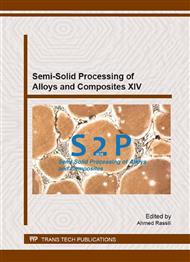p.276
p.282
p.288
p.294
p.303
p.309
p.314
p.319
p.328
A New Rheo-HPDC Process with Air-Cooled Stirring Rod Device for Wireless Base Station Shells of Al-8Si Alloy
Abstract:
A new process so-called air-cooled stirring rod (ACSR) was developed to prepare semisolid slurries of Al-8Si alloy. A simplified rheological high pressure die-casting (Rheo-HPDC) process was developed by combining the ACSR device with a HPDC machine to form wireless base station shells. Microstructures of slurries at different rotation speeds and air flows prepared by ACSR device were studied. Microstructures, mechanical properties and thermal conductivities of the shells formed by Rheo-HPDC were studied and compared with those produced by HPDC. The results indicate the ACSR device can prepare slurries in which primary particles are fine, spherical and uniformly distributed in the matrix. As rotation speed or air flow increases, the size of primary particles (α1-Al) decreases and shape factor increases. Rheo-HPDC parts show improved properties to those formed by HPDC, and increasing rates of ultimate tensile strength, yield strength, elongation, hardness and thermal conductivity are 15.4%, 8.2%, 62.1%, 6.67% and 2.1%, respectively.
Info:
Periodical:
Pages:
303-308
Citation:
Online since:
September 2016
Authors:
Price:
Сopyright:
© 2016 Trans Tech Publications Ltd. All Rights Reserved
Share:
Citation:


